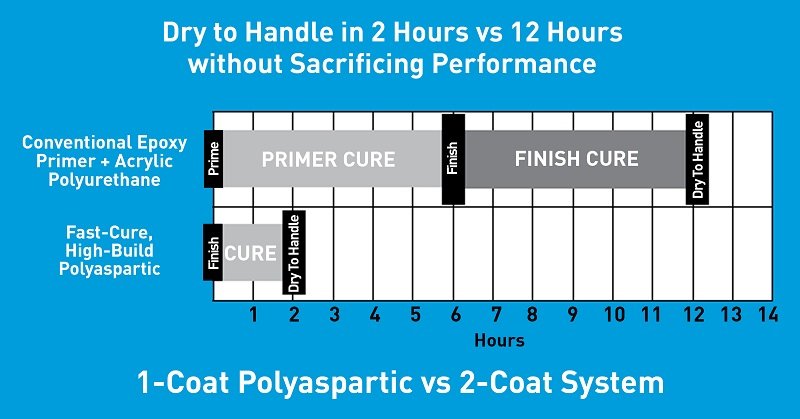Save Time and Money with Polyaspartic Technology
Originally Published: BIC, June/July 2019
New developments in polyaspartic chemistry have resulted in high-performance, quick-curing coatings with better UV resistance. Polyaspartics can be high-build, one-coat and applied directly to metal, saving significant time and money.
Polyaspartic coatings were first introduced in the early 1990s. Since that time, the technology has come a long way in speeding up the painting process in a variety of industries. A polyaspartic is similar to polyurethane; while a polyaspartic is made from aspartic ester and isocyanate, polyurethane is made from polyol and isocyanate. Both consist of a “part A” and a “part B.” However, it’s a different chemical when it’s done reacting. Generally, a polyaspartic is faster-curing, can cure at lower temperatures and has better chemical resistance, but its weathering resistance isn’t as good as a polyurethane’s. This is no longer true. With a new formulation, the weathering issue has been solved. Polyaspartics need moisture to react. Therefore, they’re more forgiving of high-humidity climates.
There is now a fast-cure polyaspartic anti-corrosion coating designed to be applied in one coat at 6-10 mils dry film thickness (DFT) and dry to handle in 1-2 hours (dry to touch in 30 minutes). Unlike previously developed coatings, these coatings provide excellent corrosion protection with just one coat applied directly to metal (DTM). Older technology required a primer, while this new development can be applied either DTM or over a primer. Another breakthrough is its highly durable finish, which resists typical mechanical damage to help reduce future maintenance costs. Additionally, it provides excellent color and gloss retention in UV exposure, exceeding products previously available. This new development exceeds the long-term weatherability requirements of SSPC Coating Specification No. 39 Level 3A (2,000 hours of testing), which is the highest level of color and gloss performance for polyaspartics. It also recently surpassed SSPC Coating Specification No. 36 Level 3A (3,000 hours of testing), which is the highest level for aliphatic polyurethane. It still exceeds Paint 36 Level 3A after 5,088 hours of exposure. This high-solids, low-VOC coating provides negligible hazardous air pollutants, so it is safer to use and compliant with regulations in most geographic areas of the U.S.
The focus of this new polyaspartic coating is to provide fast and easy-to-apply finish coats. This can help speed up the painting process by eliminating the need for typical primers and/or intermediate coats. This can be done without sacrificing performance due to its high film integrity and protective properties.

Regardless of your industry, faster throughput is very important. A fast, weatherable finish can help users — from new construction project managers to OEM fabricators — drastically speed up their production time. A tank fabrication facility previously was able to complete only five tanks per day due to overnight curing requirements of the coating. Using the newer polyaspartic technology, it averages more than 20 tanks per day. That is a four-fold increase in production rate brought about through better coating technology. Another storage container shop was having issues with its current coating not curing in high humidity and the color fading. That shop now uses the fast-cure polyaspartic in a red, dry grind color to ensure maximum coverage and color retention. Another shop previously used an epoxy/urethane system. Due to a backup in production, this shop decided to put on one coat of the fast-cure polyaspartic instead of the normal two coats, thereby speeding up the process without sacrificing performance.
By: Tricia Carter, Carboline Company

